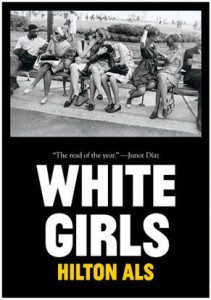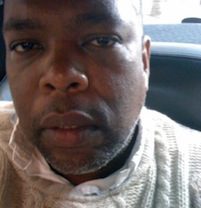
In reviewing White Girls, I would be remiss in not recounting the physical experience I had reading this book, out-in-the-world, as a white girl. Its cover, with its provocative title, made quite a travel companion. Drawn to reading it in public spaces, cafes, buses, trains, I found that people were equally drawn to watching me read it. Each time I took it out of my bag, people glanced at me wide-eyed, as if merely the title White Girls was too much out-loud talk about race in public.
One particularly meta moment came while riding the 30 Stockton bus through Chinatown. A group of young black kids listened to Eminem on a boom box whine out the phrase “Superman ain’t savin shit” at the precise moment I was reading Als’ statement about Eminem: “To say, as many critics have, that whites steal from blacks who originate important work in music or fashion is beside the point….Mathers never claimed whiteness and its privileges as his birthright because he didn’t feel white and privileged.” There in that moment, I couldn’t help but realize that things were being said that we couldn’t or wouldn’t talk about with one another on an everyday bus ride. A man sitting next to me leaned over and asked, “What the hell kind of book is that?”
Which, as it turns out, was a difficult question to answer. White Girls feels so new, (despite the fact that it’s largely comprised of previously published material) layered and unexpected. This is an extraordinary collection of essays—a lyrical hybrid of fiction, criticism and creative nonfiction, all dealing with issues of race, gender, identity, and privilege. The book is about white girls. I am undoubtedly a white girl, but according to Als’ definition, so are Michael Jackson and Truman Capote. The white girls he writes about are sometimes white and sometimes girls but always “white girls.” Catch the drift? Being a white girl isn’t about being born white in a woman’s body. It’s a state of mind, a way of acting, the pose of privilege.
Like with Eminem: Als is thinking about race less as a matter of skin color, gender as less of a matter of biological genitalia, and sexual identity as less than who you want to sleep with. Als’ insinuation that Mathers isn’t white is a radical notion for a writer of color, but it confirms his larger vision of “people as penumbrae.” Writing on how masculinity relates to power and violence, Als asserts that Truman Capote “became a woman” with the seductive reclining photograph that appeared on the dust jacket of his novel, Other Voices, Other Rooms, then Capote “became a man with the publication of his “big” book, In Cold Blood.” He also relates queerness to being a white girl. On Michael Jackson: “A number of black gay men began to refer to Jackson as ‘she’ and, eventually, ‘a white woman’ – one of the slurs they feared most, for what could be worse than being called that which you were not, could never be?” And then this turn: “There’s the bizarre fact that queerness reads, even to some black gay men themselves, as a kind of whiteness.”
The book’s premise is at first disarming and disorienting. What do black men have in common with white women, you may be asking? Als says that Richard Pryor’s “best work showed us that black men like him and the white women they loved were united in their disenfranchisement.” This is his idea of “people as penumbrae”: Als arranges his subjects, which range from Louise Brooks to Malcolm X’s mother, somewhere between complete shadow and illumination. This, he well knows, is where the most interesting light is. It’s also where the most revealing shades of our identities—like the different hues of disenfranchisement—overlap in surprising and often unexplored ways.

Als is painfully aware of the limitations of both race and language. “Language, no matter how stupid, always leaves someone out.” He writes about the prisons of language and the body, how “words limit things.” And he tries to subvert the form by breaking through these structural prisons, fissuring the language that supports them, presenting sentences that double on themselves and defy expectations. He calls black men white women. He turns the essay form it on its head. Als knows that great writing happens not in identifying what a person is, but in asking people what they identify with, what mask they are wearing. “When this mask cracks – underneath it, that is writing. How rarely does that happen?” It is rare to see a writer removing not only his mask but ours as well.
Als also calls attention to the too often ignored issue of being black and writing for a predominantly white world of publishing. “What isn’t discussed is what interests the largely white editors (who constitute what we call Publishing) have in hiring a colored person to describe a nigger’s life.”
The subject of blackness has taken a strange and unsatisfying journey through American thought: first, because blackness has almost always had to explain itself to a largely white audience in order to be heard, and, second, because it has generally been assumed to have only one story to tell – a story of oppression that plays on liberal guilt.
Als knows that his writing is being co-opted for a largely white liberal readership. In his essay about watching Gone With The Wind as a child, he asks, “What is the relationship of the white people in these pictures to the white people who ask me, and sometimes pay me, to be a Negro on the page?”
So many critiques and essays written about race are suffused with fear, and tiptoe around bold assertions. It’s no wonder Als writes so deftly about Pryor: like Pryor, he blazes ahead with a commitment to speak his own truths. Most books make a contract with the reader, but Hilton Als knows that to read without a contract is the best way to discover new shades of thought. He is a poet on the page, and his insistence on breaking the essay form defines his liberation as a writer. The triumph of White Girls is when I to say to the guy on the bus, “I have no idea what kind of book this is.”




